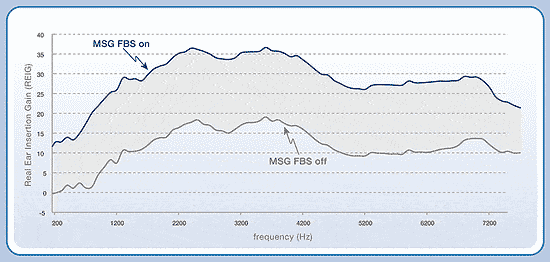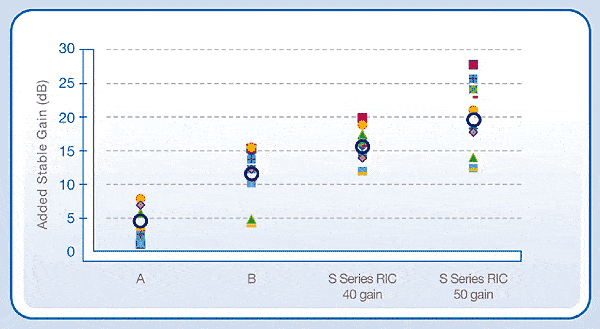The performance of feedback suppression algorithms varies greatly across hearing aids from different manufacturers and patients. With real-ear equipment, there are clinically accessible measures you can use to benchmark feedback suppression algorithms and understand them better for your own practice.
Professionals are fitting open-canal behind-the-ear (BTE) hearing aids to more patients than ever before. This is reflected in the growth of BTE hearing aid sales, which now account for 60% of all hearing aids sold in the United States.1 Patients, in turn, experience reduced occlusion and improved sound quality and comfort as a result of these open-canal fittings.2
Advancements in feedback suppression algorithms have made many of these beneficial features possible. Despite the advancements, professionals have undoubtedly noticed considerable variability in the performance of feedback suppression systems across products and patients. The observed variability in the performance of a feedback suppression algorithm is expected due to several factors, including differences in manufacturers’ feedback suppression algorithms, patients’ pinna and ear canal geometries, venting effects, and prescribed gains.
In open-canal fittings, the ear canal acts as a large vent, increasing acoustic leakage and increasing the difficulty of managing feedback. In occluded fittings, feedback is typically restricted to a range of high-frequencies, most often between 3,000 Hz and 5,000 Hz. Compare this to the open-canal fitting configuration where the energy of the acoustic leakage flattens and some peaks have shifted downward in frequency. The management of increased acoustic leakage across a wider range of frequencies makes feedback suppression in open-canal fittings more complex and creates a challenging condition for feedback suppression algorithms.
How to Measure Added Stable Gain in 8 Easy Steps
The most commonly accepted measure for the evaluation of feedback suppression algorithms is added stable gain (ASG)—the difference between two measurements of maximum stable gain (MSG). MSG is the highest amount of gain that can be provided by a hearing aid without audible feedback or degraded sound quality due to feedback oscillation, with or without feedback suppression active (Figure 1). The measurement of ASG has been adopted by hearing instrument manufacturers and independent research laboratories.3,4 The single number ASG value references the largest difference between two MSG responses; the first measured with the feedback suppression (FBS) inactive, and the second measured after the FBS has been activated.

FIGURE 1. Two measures of maximum stable gain are shown as a function of frequency. The bottom response is recorded with feedback suppression off and the top response is with feedback suppression active. The gray-shaded area between these curves represents the added stable gain.
One benefit of using ASG as a metric of feedback suppression performance is that it can be measured clinically. Here are the eight steps for measuring ASG:
1) Disable the FBS algorithm in the fitting software.
2) Disable the probe microphone system’s reference microphone, or select a measurement method that uses a stored microphone equalization.
3) Gradually raise broadband gain of the hearing aid until feedback is audible. Decrease gain until audible feedback stops.
4) Record the response and label this MSG with the “FBS off.”
5) Activate the FBS algorithm. The active feedback suppressor may increase the range of stable gain.
6) Gradually turn up the broadband gain of the hearing aid. Increase the gain until audible feedback is heard or the maximum gain in the hearing aid has been reached. If audible feedback occurs, decrease the gain until it stops.
7) Record a second response. This is MSG with “FBS on.”
8) Subtract MSG with “FBS off” from the MSG with “FBS on” to determine the ASG. This is the additional gain provided by the FBS algorithm in the hearing aid (Figure 1).
Clinical Comparisons and Analysis of ASG Measures
ASG measures were made using recently released receiver-in-canal (RIC) products from three leading hearing instrument manufacturers. Two of the tested products were Starkey S Series RICs, one with a 40 dB gain receiver and the other with a 50 dB gain receiver. The other two hearing aids feature what their respective manufacturers promote as “industry-leading” feedback suppression algorithms.
The four hearing aids were fitted monaurally to 10 adult participants with open-canal configurations. The fittings did not include the manufacturer’s proprietary earbud or dome. Each earbud would occlude the ear differently and may affect the in situ response. By removing the earbud, a true open-canal fitting was achieved in all participants. This was confirmed by comparing the real-ear unaided response to the occluded response. The ASG values were recorded using the 8-step methodology described above.
Figure 2 shows individual ASGs for the 10 participants across the four RIC products. The hearing aids are rank-ordered by mean ASG. Device A had the lowest overall ASG with a mean of 4 dB and a range between 1 dB and 7 dB. As indicated by the manufacturer’s programming software, the feedback suppression strategy of Device A places a restriction or “cap” on available gain during the initialization process. Implementation of gain capping helps to prevent feedback and can reduce the need for aggressive FBS processing. In products that implement a gain capping strategy, real-ear verification is recommended to ensure that restriction of available gain does not compromised audibility. Device B uses a similar, although less aggressive, strategy for capping gain with initialization of the FBS. In this product, the mean ASG was 11 dB with a range between 4 dB and 15 dB.

FIGURE 2. Added stable gain (ASG) is shown across four hearing aids. The multi-colored icons show individual ASG values and navy circles show mean data.
The last two devices, Starkey S Series 11 RICs, use identical signal processing. The difference between these two hearing aids is the receiver matrix and the available band gains. Measurements using the S Series RIC with a 40 dB gain receiver showed a mean ASG of 16 dB and a range between 12 dB and 20 dB. This range is similar to that of device A and well within the range referenced in the existing literature (for a review, see Ricketts et al4).
In 6 of the 10 participants tested, the maximum available gain of the S Series 40 dB gain RIC was reached in an open-canal without feedback. In contrast to devices A and B, S Series hearing aids do not implement a gain restriction; rather, any gain limitations are achieved at the maximum capability of the receiver. The S Series 50 dB gain RIC provides available band gains that are sufficient to reach the limitations of the FBS algorithm. The ASG obtained in this open-canal fitting was between 12 dB and 28 dB with a mean of 20 dB across the test group. The lowest recorded ASG measures for both S Series hearing aids were 12 dB, similar to the mean ASG in product B and above all ASG measures for product A.
Discussion
Consistent trends were observed across the open-canal RIC hearing aid fittings evaluated in this study. Measures from the same two participants resulted in the poorest ASG values across most of the tested hearing aids in this study. Otoscopic examination revealed that each of these participants’ ear canals has a tortuous first bend that resulted in receiver placement with close proximity to the canal wall. The lack of ideal receiver placement likely limited the performance of the tested FBS systems.
The importance of appropriate receiver placement is by no means a new topic. For any hearing aid fitting—whether open-canal or occluded—the sound port or receiver should be placed appropriately in the canal. The same consideration must be made in an open-canal fitting. Today’s RIC and thin-tube products offer numerous options for soft silicone earbuds. These earbuds may not maintain proper orientation of the sound port or receiver, increasing the likelihood of feedback. When a soft-silicone earbud cannot maintain proper receiver orientation, a custom earmold should be considered.
These data and observations reinforce the fact that there are differences across FBS algorithm performance. Understanding the behavior of modern FBS algorithms is important in order to set appropriate clinical expectations. For example, some FBS algorithms effectively suppress feedback; in other cases, gain limitations have been introduced at frequencies that generate feedback. The gain-limiting strategy may also limit the fitting range of some open-canal devices. Differences in FBS performance will depend on many factors: the coupling method (eg, earbud vs earmold), the acoustics of each patient’s ears, the manufacturer’s development philosophy, the quality of the FBS design, and the mechanical build quality of that hearing aid.
Conclusions
Modern feedback suppression algorithms have increased clinical fitting ranges, allowing more patients access to unoccluding or open fitting styles. However, it is necessary for clinicians to educate themselves on manufacturer’s products and the techniques used for feedback suppression whenever possible.
The evaluation of an FBS algorithm can be done using routine real-ear probe microphone equipment to measure a patient’s ASG. An objective measure, like the ASG, will help establish appropriate clinical expectations for fitting ranges to ensure that patients receive a prescriptively appropriate fitting in the most open configuration possible.
References
- Kiessling J, Brenner B, Jespersen CT, Groth J, Jensen OD. Occlusion effect of earmolds with different venting systems. J Am Acad Audiol. 2005;16:237-249.
- Hearing Industries Association (HIA). HIA Quarterly Market Statistics Survey. Washington, DC: HIA; 2009.
- Banerjee S, Recker K, Paumen A. A tale of two feedback cancellers. Hearing Review. 2006;13(7):40-44.
- Ricketts TA, Johnson EE, Federman J. Individual differences within and across feedback suppression hearing aids. J Am Acad Audiol. 2008;19(10):1-24.
Citation for this article:
Galster JA, Galster EA. How to compare feedback suppression algorithms in open-canal fittings. Hearing Review. 2010;17(11):38-41.







